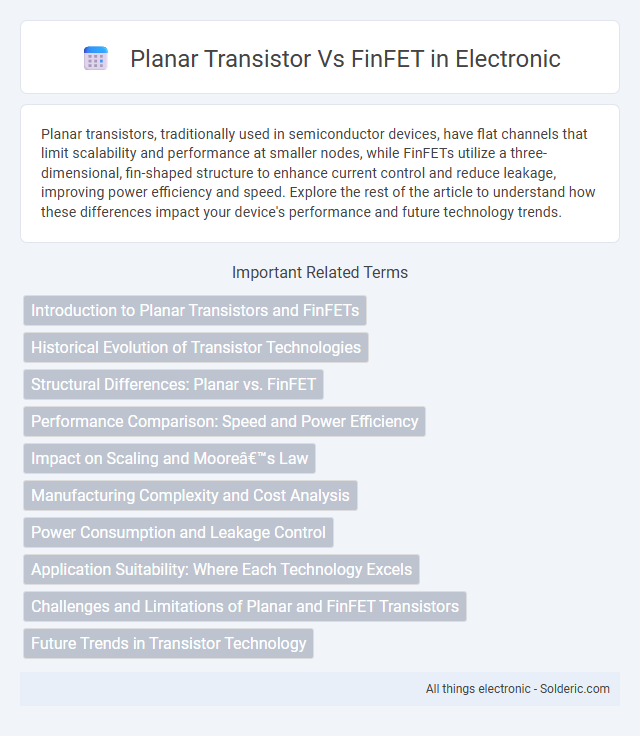Planar transistors, traditionally used in semiconductor devices, have flat channels that limit scalability and performance at smaller nodes, while FinFETs utilize a three-dimensional, fin-shaped structure to enhance current control and reduce leakage, improving power efficiency and speed. Explore the rest of the article to understand how these differences impact your device's performance and future technology trends.
Comparison Table
| Feature | Planar Transistor | FinFET |
|---|---|---|
| Structure | Flat, 2D channel | 3D, vertical fin-shaped channel |
| Gate Control | Single-gate | Multi-gate (typically tri-gate) |
| Leakage Current | Higher leakage due to short-channel effects | Significantly reduced leakage |
| Scaling | Limited scaling below 20nm | Effective scaling below 10nm |
| Performance | Lower drive current and speed | Higher drive current and faster switching |
| Power Efficiency | Less power-efficient | Improved power efficiency |
| Manufacturing Complexity | Simpler manufacturing process | More complex, requiring advanced lithography |
| Applications | Older technology nodes, cost-sensitive devices | Modern high-performance CPUs, GPUs, and SoCs |
Introduction to Planar Transistors and FinFETs
Planar transistors, traditionally used in semiconductor devices, feature a flat channel where current flows horizontally between the source and drain terminals. FinFETs, or Fin Field-Effect Transistors, introduce a three-dimensional structure with a vertical fin that enhances electrostatic control over the channel, which reduces leakage current and improves performance at smaller technology nodes. Your choice between planar transistors and FinFETs impacts power efficiency, scaling potential, and device reliability in advanced integrated circuits.
Historical Evolution of Transistor Technologies
The historical evolution of transistor technologies marked a shift from planar transistors dominating early semiconductor design to FinFETs revolutionizing modern integrated circuits with enhanced control over short-channel effects. Planar transistors, developed in the mid-20th century, faced scaling limitations due to increased leakage currents and reduced gate control at sub-22nm nodes. FinFET technology, introduced commercially around 2011, overcame these challenges by employing triple-gate structures, enabling continued transistor scaling and improved performance in advanced digital devices.
Structural Differences: Planar vs. FinFET
Planar transistors feature a flat channel lying horizontally on the semiconductor substrate, while FinFETs utilize a three-dimensional fin structure that extends vertically from the substrate, enhancing gate control. The FinFET's wrap-around gate design encases the fin on multiple sides, significantly reducing leakage current compared to the single-sided gate of planar transistors. Your device's performance and power efficiency benefit from the superior electrostatic control offered by FinFET's distinctive 3D architecture.
Performance Comparison: Speed and Power Efficiency
FinFET transistors deliver superior speed and power efficiency compared to planar transistors due to their three-dimensional gate structure, which provides better channel control and reduces leakage current. The enhanced electrostatic control in FinFETs lowers short-channel effects, enabling higher drive current and faster switching speeds while consuming less power. As a result, FinFET technology is preferred in advanced semiconductor nodes for high-performance and energy-efficient applications.
Impact on Scaling and Moore’s Law
FinFET technology significantly improves transistor scaling compared to Planar transistors by providing better electrostatic control and reducing short-channel effects, enabling continued adherence to Moore's Law. Planar transistors face increased leakage and performance issues at smaller nodes, whereas FinFETs maintain efficiency and power management at sub-10nm scales. Your next-generation semiconductor devices benefit from FinFET's scalability, supporting higher transistor density and improved performance in advanced integrated circuits.
Manufacturing Complexity and Cost Analysis
Planar transistors have a simpler manufacturing process with well-established fabrication techniques, leading to lower production costs compared to FinFETs. FinFET technology involves complex 3D structures that require advanced lithography and etching processes, significantly increasing manufacturing complexity and expenses. Your choice between planar transistors and FinFETs will impact device performance and overall semiconductor production costs.
Power Consumption and Leakage Control
FinFET transistors significantly reduce power consumption and leakage current compared to planar transistors due to their 3D fin structure, which offers superior electrostatic control over the channel. The FinFET design minimizes short-channel effects and subthreshold leakage, enabling lower threshold voltages and improved energy efficiency. Planar transistors, with their 2D channel, experience increased leakage and power dissipation as device dimensions shrink, limiting scalability for advanced low-power applications.
Application Suitability: Where Each Technology Excels
Planar transistors excel in applications requiring simpler manufacturing processes and cost-effective solutions for lower power and performance demands, such as in basic microcontrollers and low-end processors. FinFET technology is ideal for high-performance, energy-efficient computing in advanced semiconductor nodes, powering smartphones, high-end CPUs, and GPUs with superior control over short-channel effects and leakage currents. Your choice depends on prioritizing either cost-efficiency and maturity with planar transistors or cutting-edge performance and power efficiency with FinFETs.
Challenges and Limitations of Planar and FinFET Transistors
Planar transistors face challenges such as short-channel effects, leakage currents, and scaling limitations below 22 nm, which restrict their performance in advanced nodes. FinFET transistors, while offering better control over channel electrostatics and reduced leakage, encounter complexities in fabrication, increased variability, and higher production costs. Both technologies face trade-offs between performance, power consumption, and manufacturability as semiconductor nodes advance toward 3 nm and beyond.
Future Trends in Transistor Technology
FinFET technology continues to dominate the semiconductor industry due to its superior control of short-channel effects and reduced power leakage compared to traditional planar transistors. Research is increasingly focusing on scaling FinFETs below 3nm, while emerging alternatives like Gate-All-Around (GAA) transistors promise enhanced electrostatic control and further performance boosts. The future of transistor technology hinges on integrating these advanced architectures with novel materials such as silicon-germanium and two-dimensional semiconductors to sustain Moore's Law and meet evolving power efficiency demands.
Planar transistor vs FinFET Infographic

 solderic.com
solderic.com